1.编程实现文件合并和去重操作
对于两个输入文件,即文件A和文件B,编写MapReduce程序,对两个文件进行合并, 并剔除其中重复的内容,得到一个新的输出文件C。下面是输入文件和输出文件的一个样 例供参考。
输入文件A的样例如下:

输入文件B的样例如下:

根据输入文件A和B合并得到的输出文件C的样例如下:

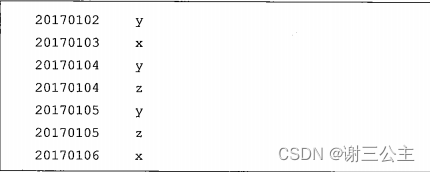
操作过程
1.启动 hadoop:

需要首先删除HDFS中与当前Linux用户hadoop对应的input和output目录(即HDFS中的“/opt/module/hadoop-3.1.3/input”和“/opt/module/hadoop-3.1.3/output”目录),这样确保后面程序运行不会出现问题

再在HDFS中新建与当前Linux用户hadoop对应的input目录,即“/opt/module/hadoop-3.1.3/input”目录
创建A.txt B.txt,输入上述内容

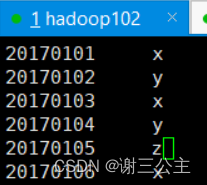
将A,B上传到HDFS中

Java代码:
package com.xusheng.mapreduce.shiyan;
import org.apache.hadoop.conf.Configuration;
import org.apache.hadoop.fs.Path;
import org.apache.hadoop.io.Text;
import org.apache.hadoop.mapreduce.Job;
import org.apache.hadoop.mapreduce.Mapper;
import org.apache.hadoop.mapreduce.Reducer;
import org.apache.hadoop.mapreduce.lib.input.FileInputFormat;
import org.apache.hadoop.mapreduce.lib.output.FileOutputFormat;
import java.io.IOException;
public class Merge {
/**
* @param xusheng
* 对A,B两个文件进行合并,并剔除其中重复的内容,得到一个新的输出文件C
*/
//重载map函数,直接将输入中的value复制到输出数据的key上
public static class Map extends Mapper<Object, Text, Text, Text>{
private static Text text = new Text();
public void map(Object key, Text value, Context context) throws IOException,InterruptedException{
text = value;
context.write(text, new Text(""));
}
}
//重载reduce函数,直接将输入中的key复制到输出数据的key上
public static class Reduce extends Reducer<Text, Text, Text, Text>{
public void reduce(Text key, Iterable<Text> values, Context context ) throws IOException,InterruptedException{
context.write(key, new Text(""));
}
}
public static void main(String[] args) throws Exception{
// TODO Auto-generated method stub
Configuration conf = new Configuration();
//conf.set("fs.default.name","hdfs://localhost:9000");
conf.set("fs.defaultFS","hdfs://hadoop102:8020");
String[] otherArgs = new String[]{"/input/test1","/output/test1"}; //* 直接设置输入参数 *//*
if (otherArgs.length != 2) {
System.err.println("Usage: wordcount <in><out>");
System.exit(2);
}
Job job = Job.getInstance(conf,"Merge and duplicate removal");
job.setJarByClass(Merge.class);
job.setMapperClass(Map.class);
job.setCombinerClass(Reduce.class);
job.setReducerClass(Reduce.class);
job.setOutputKeyClass(Text.class);
job.setOutputValueClass(Text.class);
FileInputFormat.addInputPath(job, new Path(otherArgs[0]));
FileOutputFormat.setOutputPath(job, new Path(otherArgs[1]));
System.exit(job.waitForCompletion(true) ? 0 : 1);
}
}
结果:

2.编写程序实现对输入文件的排序
现在有多个输入文件,每个文件中的每行内容均为一个整数。要求读取所有文件中的 整数,进行升序排序后,输出到一个新的文件中,输出的数据格式为每行两个整数,第一个数 字为第二个整数的排序位次,第二个整数为原待排列的整数。下面是输入文件和输出文件 的一个样例供参考。
输入文件1的样例如下:

输入文件2的样例如下:

输入文件3的样例如下:

根据输入文件1、2和3得到的输出文件如下:


操作过程
1.创建1.txt ,2.txt ,3.txt,输入上述内容
再在HDFS中新建与当前Linux用户hadoop对应的input目录,即“/opt/module/hadoop-3.1.3/input”目录

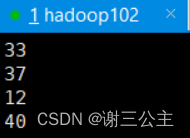
将1.txt ,2.txt ,3.txt上传到HDFS中


Java代码:
package com.xusheng.mapreduce.shiyan;
import java.io.IOException;
import org.apache.hadoop.conf.Configuration;
import org.apache.hadoop.fs.Path;
import org.apache.hadoop.io.IntWritable;
import org.apache.hadoop.io.Text;
import org.apache.hadoop.mapreduce.Job;
import org.apache.hadoop.mapreduce.Mapper;
import org.apache.hadoop.mapreduce.Partitioner;
import org.apache.hadoop.mapreduce.Reducer;
import org.apache.hadoop.mapreduce.lib.input.FileInputFormat;
import org.apache.hadoop.mapreduce.lib.output.FileOutputFormat;
import org.apache.hadoop.util.GenericOptionsParser;
public class MergeSort {
/**
* @param xusheng
* 输入多个文件,每个文件中的每行内容均为一个整数
* 输出到一个新的文件中,输出的数据格式为每行两个整数,第一个数字为第二个整数的排序位次,第二个整数为原待排列的整数
*/
//map函数读取输入中的value,将其转化成IntWritable类型,最后作为输出key
public static class Map extends Mapper<Object, Text, IntWritable, IntWritable>{
private static IntWritable data = new IntWritable();
public void map(Object key, Text value, Context context) throws IOException,InterruptedException{
String text = value.toString();
data.set(Integer.parseInt(text));
context.write(data, new IntWritable(1));
}
}
//reduce函数将map输入的key复制到输出的value上,然后根据输入的value-list中元素的个数决定key的输出次数,定义一个全局变量line_num来代表key的位次
public static class Reduce extends Reducer<IntWritable, IntWritable, IntWritable, IntWritable>{
private static IntWritable line_num = new IntWritable(1);
public void reduce(IntWritable key, Iterable<IntWritable> values, Context context) throws IOException,InterruptedException{
for(IntWritable val : values){
context.write(line_num, key);
line_num = new IntWritable(line_num.get() + 1);
}
}
}
//自定义Partition函数,此函数根据输入数据的最大值和MapReduce框架中Partition的数量获取将输入数据按照大小分块的边界,然后根据输入数值和边界的关系返回对应的Partiton ID
public static class Partition extends Partitioner<IntWritable, IntWritable>{
public int getPartition(IntWritable key, IntWritable value, int num_Partition){
int Maxnumber = 65223;//int型的最大数值
int bound = Maxnumber/num_Partition+1;
int keynumber = key.get();
for (int i = 0; i<num_Partition; i++){
if(keynumber<bound * (i+1) && keynumber>=bound * i){
return i;
}
}
return -1;
}
}
public static void main(String[] args) throws Exception{
// TODO Auto-generated method stub
Configuration conf = new Configuration();
//conf.set("fs.default.name","hdfs://localhost:9000");
conf.set("fs.defaultFS","hdfs://hadoop102:8020");
String[] otherArgs = new String[]{"/input/test2","/output/test2"}; /* 直接设置输入参数 */
if (otherArgs.length != 2) {
System.err.println("Usage: wordcount <in><out>");
System.exit(2);
}
Job job = Job.getInstance(conf,"Merge and sort");//实例化Merge类
job.setJarByClass(MergeSort.class);//设置主类名
job.setMapperClass(Map.class);//指定使用上述代码自定义的Map类
job.setReducerClass(Reduce.class);//指定使用上述代码自定义的Reduce类
job.setPartitionerClass(Partition.class);
job.setOutputKeyClass(IntWritable.class);
job.setOutputValueClass(IntWritable.class);//设定Reduce类输出的<K,V>,V类型
FileInputFormat.addInputPath(job, new Path(otherArgs[0]));//添加输入文件位置
FileOutputFormat.setOutputPath(job, new Path(otherArgs[1]));//设置输出结果文件位置
System.exit(job.waitForCompletion(true) ? 0 : 1);//提交任务并监控任务状态
}
}
结果:
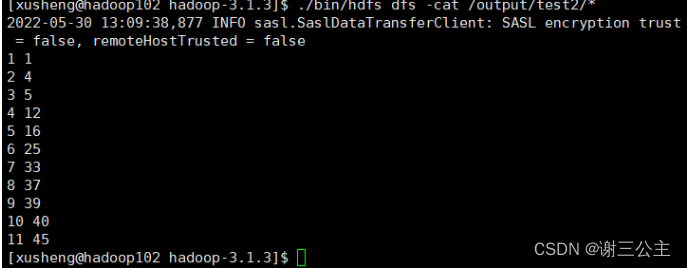
3.对给定的表格进行信息挖掘
下面给出一个child-parent的表格,要求挖掘其中的父子关系,给出祖孙关系的表格。 输入文件内容如下:
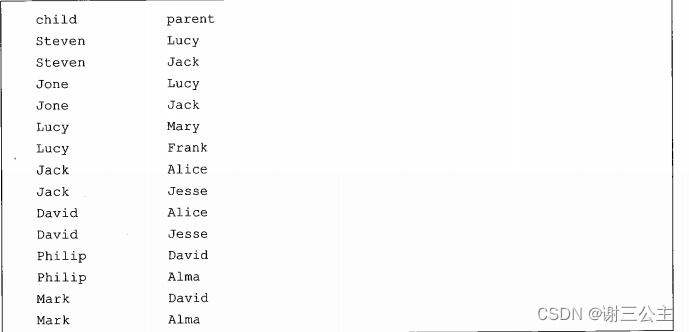
输出文件内容如下:
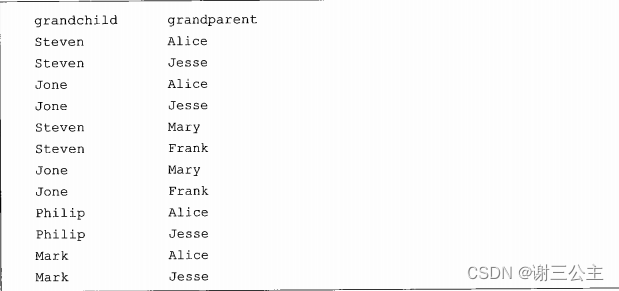
操作过程
1.创建child.txt,输入上述内容
再在HDFS中新建与当前Linux用户hadoop对应的input目录,即“/opt/module/hadoop-3.1.3/input”目录

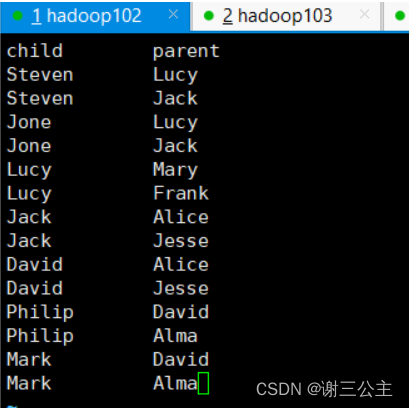
- 将child.txt上传到HDFS中

Java代码:
package com.xusheng.mapreduce.shiyan;
import java.io.IOException;
import java.util.*;
import org.apache.hadoop.conf.Configuration;
import org.apache.hadoop.fs.Path;
import org.apache.hadoop.io.IntWritable;
import org.apache.hadoop.io.Text;
import org.apache.hadoop.mapreduce.Job;
import org.apache.hadoop.mapreduce.Mapper;
import org.apache.hadoop.mapreduce.Reducer;
import org.apache.hadoop.mapreduce.lib.input.FileInputFormat;
import org.apache.hadoop.mapreduce.lib.output.FileOutputFormat;
import org.apache.hadoop.util.GenericOptionsParser;
public class simple_data_mining {
public static int time = 0;
/**
* @param xusheng
* 输入一个child-parent的表格
* 输出一个体现grandchild-grandparent关系的表格
*/
//Map将输入文件按照空格分割成child和parent,然后正序输出一次作为右表,反序输出一次作为左表,需要注意的是在输出的value中必须加上左右表区别标志
public static class Map extends Mapper<Object, Text, Text, Text>{
public void map(Object key, Text value, Context context) throws IOException,InterruptedException{
String child_name = new String();
String parent_name = new String();
String relation_type = new String();
String line = value.toString();
int i = 0;
while(line.charAt(i) != ' '){
i++;
}
String[] values = {line.substring(0,i),line.substring(i+1)};
if(values[0].compareTo("child") != 0){
child_name = values[0];
parent_name = values[1];
relation_type = "1";//左右表区分标志
context.write(new Text(values[1]), new Text(relation_type+"+"+child_name+"+"+parent_name));
//左表
relation_type = "2";
context.write(new Text(values[0]), new Text(relation_type+"+"+child_name+"+"+parent_name));
//右表
}
}
}
public static class Reduce extends Reducer<Text, Text, Text, Text>{
public void reduce(Text key, Iterable<Text> values,Context context) throws IOException,InterruptedException{
if(time == 0){ //输出表头
context.write(new Text("grand_child"), new Text("grand_parent"));
time++;
}
int grand_child_num = 0;
String grand_child[] = new String[10];
int grand_parent_num = 0;
String grand_parent[]= new String[10];
Iterator ite = values.iterator();
while(ite.hasNext()){
String record = ite.next().toString();
int len = record.length();
int i = 2;
if(len == 0) continue;
char relation_type = record.charAt(0);
String child_name = new String();
String parent_name = new String();
//获取value-list中value的child
while(record.charAt(i) != '+'){
child_name = child_name + record.charAt(i);
i++;
}
i=i+1;
//获取value-list中value的parent
while(i<len){
parent_name = parent_name+record.charAt(i);
i++;
}
//左表,取出child放入grand_child
if(relation_type == '1'){
grand_child[grand_child_num] = child_name;
grand_child_num++;
}
else{//右表,取出parent放入grand_parent
grand_parent[grand_parent_num] = parent_name;
grand_parent_num++;
}
}
if(grand_parent_num != 0 && grand_child_num != 0 ){
for(int m = 0;m<grand_child_num;m++){
for(int n=0;n<grand_parent_num;n++){
context.write(new Text(grand_child[m]), new Text(grand_parent[n]));
//输出结果
}
}
}
}
}
public static void main(String[] args) throws Exception{
// TODO Auto-generated method stub
Configuration conf = new Configuration();
//conf.set("fs.default.name","hdfs://localhost:9000");
conf.set("fs.default.name","hdfs://hadoop102:8020");
String[] otherArgs = new String[]{"/input/test3","/output/test3"}; /* 直接设置输入参数 */
if (otherArgs.length != 2) {
System.err.println("Usage: wordcount <in><out>");
System.exit(2);
}
Job job = Job.getInstance(conf,"Single table join");
job.setJarByClass(simple_data_mining.class);
job.setMapperClass(Map.class);
job.setReducerClass(Reduce.class);
job.setOutputKeyClass(Text.class);
job.setOutputValueClass(Text.class);
FileInputFormat.addInputPath(job, new Path(otherArgs[0]));
FileOutputFormat.setOutputPath(job, new Path(otherArgs[1]));
System.exit(job.waitForCompletion(true) ? 0 : 1);
}
}
结果:
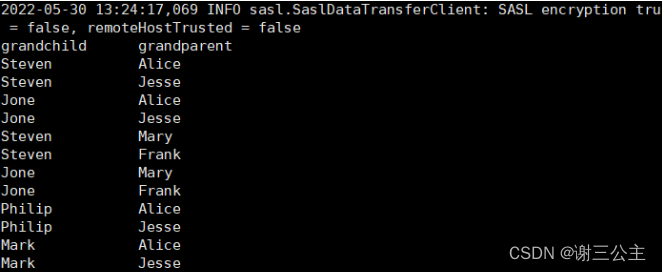























 1万+
1万+











 被折叠的 条评论
为什么被折叠?
被折叠的 条评论
为什么被折叠?








